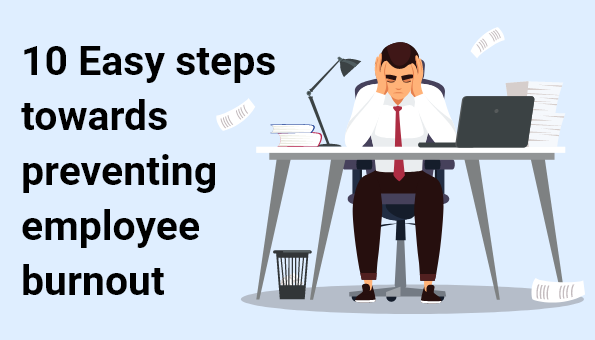Stress has become an unhealthy measure for success that often leads to employee burnout. A culture glorifying being stressed to appear successful has become typical in modern workplaces. While stress at work is normal, unmanaged stress can affect productivity and more importantly health at all levels, physical, mental and emotional health.
Reasons for employee burnout
- doneUnrealistic expectations
- doneNo clarity on job expectations
- doneUnmanageable workload
- doneLack of communication
- doneUnreasonable deadlines
- doneUnfair treatment at work
- doneCulture encouraging overtime
All of these could lead to employee burnout and eventually force employees to quit.
Prolonged and chronic stress can manifest as;
- Emotional, mental, and physical exhaustion
- Disengagement
- Increased absenteeism
- Isolation
- Higher sensitivity to feedback
- Emergence of physical symptoms
- Decreased productivity
10 easy steps to prevent employee burnout
There is no one solution to manage stress and avoid burnout but here are few options and incorporating a combination of few could improve employee wellbeing.
 1. Provide effective orientation
1. Provide effective orientation
Employee orientation is the process of introducing newly hired employees to their new workplace. It provides the basic organizational information employees need to be prepared for their new team, department, and role within the company and makes them aware of company policies and expectations.
A smooth transition into a new role benefits both new employees and their new managers and colleagues. By clearly communicating expectations and responsibilities to the new employee, they can start being productive quickly. As part of an effective onboarding process, a thorough and engaging orientation can also help reduce new employee turnover due to misunderstood or unmet expectations. A clear policy for employee orientation will ensure that all new team members receive the same training and information.
 2. Upskilling employees with training and online courses
2. Upskilling employees with training and online courses
Employees cite a lack of growth and advancement opportunities among the top five stressors to work. In an evolving technological ecosystem, helping employees obtain new skills can help them adapt to a dynamic work environment and help them grow their advancement opportunities, inside the company and outside. Encouraging employees to view stressful situations as a challenge, rather than a threat, can help them rise to the occasion. By setting clear goals together with employees, not only do managers ensure employees know what to expect, but they also can boost employee engagement.
 3. Defining job expectations and feedback
3. Defining job expectations and feedback
Employees perform better when they are provided with a clear knowledge of what is expected of them and regular feedback about their progress and improvements required of them could greatly benefit both employees and managers. This would also make employees better engage with their work, co-workers, managers and the company.
 4. Beyond regular employee benefits
4. Beyond regular employee benefits
Going beyond the standard employee benefits, like, offering a quiet space within the workplace for employees to unplug, meditate, or relax for a few minutes can help manage stress. New aesthetics for the office, plants or fish ponds can help establish a less stressful environment.
 5. Keep a watchful eye on indicators of burnout
5. Keep a watchful eye on indicators of burnout
- Emotional and physical exhaustion
- Disengagement
- Increased absenteeism
- Isolation
- Sensitivity to feedback
- Decreased productivity
 6. Rewards for achievements
6. Rewards for achievements
Recognizing employee achievements helps foster a productive and hostile-free work environment. Happy employees make a happy workplace which is essential for growth of the company. Whether it’s a pat on the back or a full-blown party, management should make efforts to notice employees’ work achievements and show them appreciation.
 7. Offer flexibility in the work environment
7. Offer flexibility in the work environment
Working from home isn’t a new concept, but managers can help eliminate stigma and ensure fair application of policy by making it a practice. For example, according to SHRM, Mojo Media Labs offers Work from Home Wednesdays, where employees at all levels work from home. This saves employees time and money commuting and demonstrates organizational trust. A hybrid work model where employees work a few days a week from the office and other days from home could help employees with children and elderly dependent parents.
 8. Promote mental health days
8. Promote mental health days
Corporate wellness programs can also promote self-care and stress management by providing mental health counseling, exercise and tobacco cessation programs. According to research by Morneau Shepell, every $1 invested in an Employee and Family Assistance Program provides more than eight times the return on investment due to improved productivity and reduced absenteeism.
Further, encourage a healthy lifestyle with employee gym memberships. Regular sessions for yoga, deep breathing exercises, mindfulness meditation can help immensely to promote employee wellness.
 9. Offer paid time off
9. Offer paid time off
Not only offering paid time off but also enforcing employees to take time off for travel and vacation is essential. Travel lets one disconnect from daily life, which relieves stress, enhances creativity, boosts happiness and satisfaction, energizes, lowers the risk of depression and burnout. Travel can also make one understand oneself better by learning to adapt to change and finding one’s strengths, which can greatly enhance one’s work too.
 10. Increase employee engagement by regularly scheduling managers one-on-one
10. Increase employee engagement by regularly scheduling managers one-on-one
One-on-One is the pulse check to know if the employee is happy, upset, or satisfied. When employees and managers communicate frequently and regularly share feedback (both ways), they’re more likely to be engaged in the workplace. One-on-one meetings are the dedicated time for employees and their managers to connect on work, career development and growth. Effectively done this would ensure comradeship in the workplace.
How to recognize and manage employee burnout
Recognizing employee burnout isn’t always tangible, but keep an eye out for the symptoms. If employees who are usually productive and motivated show some signs of employee burnout on a daily basis like exhaustion, disengagement, reduced productivity etc., then they might be burned out or close to it. Each employee may experience burnout differently, or these symptoms could result from reasons other than burnout. That’s why managers should start dealing with this issue with an open conversation and performance management software.
Performance management software for tracking and managing employee performance and productivity could help identify potential burnout.
Key features to look for in performance management software to spot potential burnout among employees
 Goal setting
Goal setting
Goal setting is the base for performance assessment. With no clear goals, employees would not know what to work towards, managers and HR would have no parameters to assess performance. Goal setting features should include space to track employees’ short-term and long-term goals. Employees will get alerts to update their goal progress and managers will get notified when their feedback is due.
 Employee recognition
Employee recognition
Appreciation for work well done gives employees a sense of pride and joy no matter where it comes from, using performance management software not only managers, even team members can recognize and appreciate each other.
 Feedback management
Feedback management
Regular feedback can ensure if the employee is on the right track with respect to the project assigned and his/her career path, if not course correct accordingly, or upskilling if necessary, which would assure employees that they are acquiring the required skills to build a fulfilling career.
 Performance analytics
Performance analytics
Performance analytics shows employees who consistently meet or exceed their KPIs should be considered for raises, bonuses, and promotions. These KPIs can also help you identify when employees are struggling and ensure they get the help they need like training, and mentoring counseling to succeed.
To better manage employee burnout, choose a performance management software with measurable metrics to track performance, identify skill gaps, provide necessary training, appreciate employees’ achievements and help them maintain a good work life balance.

 1. Provide effective orientation
1. Provide effective orientation 2. Upskilling employees with training and online courses
2. Upskilling employees with training and online courses 3. Defining job expectations and feedback
3. Defining job expectations and feedback 4. Beyond regular employee benefits
4. Beyond regular employee benefits 5. Keep a watchful eye on indicators of burnout
5. Keep a watchful eye on indicators of burnout 6. Rewards for achievements
6. Rewards for achievements 7. Offer flexibility in the work environment
7. Offer flexibility in the work environment 8. Promote mental health days
8. Promote mental health days 9. Offer paid time off
9. Offer paid time off 10. Increase employee engagement by regularly scheduling managers one-on-one
10. Increase employee engagement by regularly scheduling managers one-on-one Goal setting
Goal setting Employee recognition
Employee recognition Feedback management
Feedback management Performance analytics
Performance analytics
